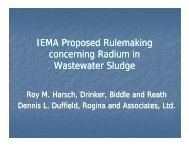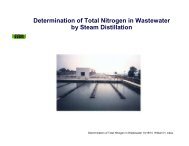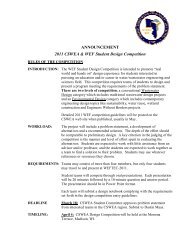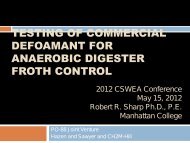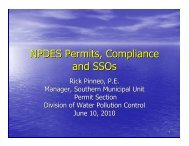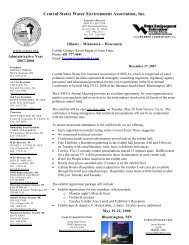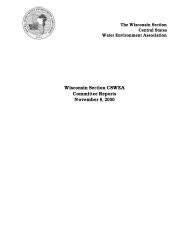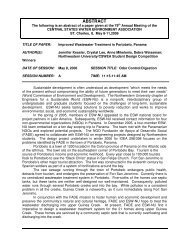The Future of Activated Sludge - Central States Water Environment ...
The Future of Activated Sludge - Central States Water Environment ...
The Future of Activated Sludge - Central States Water Environment ...
Create successful ePaper yourself
Turn your PDF publications into a flip-book with our unique Google optimized e-Paper software.
Some Thoughts ht On <strong>The</strong> <strong>Future</strong>Of Wastewater Treatment15 th Annual Education Seminar<strong>Central</strong> <strong>States</strong> <strong>Water</strong> <strong>Environment</strong> AssociationMadison, WIApril 5, 2011George TchobanoglousPr<strong>of</strong>essor Emeritus <strong>of</strong> Civil and <strong>Environment</strong>al EngineeringDepartment <strong>of</strong> Civil and <strong>Environment</strong>al EngineeringUniversity <strong>of</strong> California, Davis
Basis for PresentationWASTEWATER AND FOODWASTES ARE RENEWABLERECOVERABLESOURCES OF ENERGY,RESOURCES, AND WATER
A Question and Answer AboutWastewater Treatment in the <strong>Future</strong>QUESTIONHow can we enhance wastewatertreatment, reduce energy usage, andrecover additional energy and resources?ANSWERTo accomplish these objectives it will benecessary to modify the characteristics<strong>of</strong> the waste to be treated
Overview <strong>of</strong> Presentation• What to do with Food Waste• Wastewater Constituents and Characteristics• Energy Content <strong>of</strong> Wastewater Versus EnergyNeeded For Treatment• Modification <strong>of</strong> Wastewater Characteristics –Near-Term Interventions• Modification <strong>of</strong> Wastewater Characteristics –Long-Term Interventions• A Final Thought and Sustainability Challenge
Food Waste Management Options
Wastewater CharacteristicsConventional• Organic constituents• Inorganic constituentsAdditional• Heat energy• Chemical energy
Constituents t in WastewatertConstituent Unit Value (typical)Solids, total (TS) mg/L 390 -1230 (720)Dissolved, total (TDS) mgIL 270 – 860 (500)Suspended solids, total (TSS) mg/L 120 – 400 (210)Biochemical oxygen demand(BOD) 5-d, 20°Cmg/L 110 – 350 (190)Ttl Total organic carbon (TOC) mg/L 80 – 260 (140)Chemical oxygen demand(COD)mg/L 250 – 800 (430)Oil and grease mg/L 30 – 90 (60)Flowrate gal/capita•d 200 – 60 (120)
Energy Content <strong>of</strong> WastewaterHeat energySpecific heat <strong>of</strong> water = 4.1816 J/g •°C at 20°CChemical oxygen demand (COD)C 5 H 7 NO 2 + 5O 2 = 5CO 2 + NH 3 + 2H 2 O(113) 5(32)Chemical energy (Channiwala,1992), )HHV (MJ/kg) = 34.91 C + 117.83 H - 10.34 O- 1.51 N + 10.05 S - 2.11A
Energy Content <strong>of</strong> WastewaterConstituent Unit ValueWastewater, heat basis MJ/10°C•10 3 m 3 41,900Wastewater, COD basis MJ/kg COD 12 - 15Pi Primary sludge, dry MJ/kg TSS 15 - 15.9Secondary biosolids, dry MJ/kg TSS 12.4 - 13.5
Required and Available Energy forWastewater t Treatment, t Exclusive <strong>of</strong> Heat Energy• Energy required for secondary wastewatertreatmentt t1,200 to 2,400 MJ/1000 m 3• Energy available in wastewater for treatment,using previous dataQ = [430 kg COD/1000 m 3 ) (1000 m 3 ) (13 MJ/ kg COD)5,590 MJ/1000 m 3• Energy available in wastewater is 2 to 4 timesthe amount required for treatment
What is the Key Question – How toRecover and Use Energy ?• Anaerobic digestion and power generation• Ambient temperature anaerobic treatment andpower generation• Complete treatment without biological processingwith heat drying and power generation• Upstream recovery <strong>of</strong> heat and chemical energy
Heat Recovery from WastewaterSOURCE : City <strong>of</strong> Vancouver, Sustainability website retrieved fromhttp://vancouver.ca/sustainability/neuTechnology.htmFALSE CREEK ENERGY CENTER
Modification <strong>of</strong> WastewaterCharacteristics – Near-Term Interventions1. Reduce energy usage through reducedorganic loading2. Modify particle size to enhancetreatment3. Additional energy recovery throughanaerobic digestion4. Separate treatment for return flows5 Conversion <strong>of</strong> food waste and fats oils5. Conversion <strong>of</strong> food waste and fats, oils,and grease
Wastewater Treatment Process Flow DiagramsWith Conventional and New Technologies
Particle Size ModificationWith Primary Effluent Filtration10Volum e distributio on,/cm3V/log d p(10 7 m 3 )8642Plant 1 - 3.4 m (11 ft) side water depthPlant 2 - 5.55 m (18 ft) side water depth12-15 m0-0.5 0 0.5 1.0 1.5 2.0Log <strong>of</strong> particle diameter, d p, m
Primary Effluent Filtration with Fuzzy Filter
Primary Effluent Filtration with WesTech Disk Filter
Impact <strong>of</strong> Recycle Flows onNitrogen RemovalReturnflowscontainnitrogen
Wastewater Treatment Process Flow DiagramsWith Conventional and New Technologies
Fine Screen for Solids RemovalAdelanto, CA200 micron cloth screenFontana, CADewatered solids
Stainless Steel Cloth Filter (10 m) forStainless Steel Cloth Filter (10 m) forFiltration <strong>of</strong> Secondary Effluent
Modification <strong>of</strong> WastewaterCharacteristics – Long-Term Interventions1. Separation <strong>of</strong> waste constituents at thesource into urine and black water2. Reduce phosphate h content t <strong>of</strong>consumer products3. Alternative treatment processes andconfigurations4. Recover wastewater solids upstream insatellite stations
Use <strong>of</strong> Existing Collection System ForUse <strong>of</strong> Existing Collection System ForSource Separated Resource Streams
Nutrients and Trace Organics in DomesticWastewater: A Case for Urine SeparationGreywater10080FecesGreywaterFecesGreywaterFecesComp position, %6040UrineUrineUrineGreywaterRelativedistributionunknown,preliminaryi> 70%in urineFecesandurine200Nitrogen Phosphorus Potassium Volume Trace organicsWastewater constituentSource: Jönsson et al.(2000) Recycling Source Separated Human Urine.
Examples <strong>of</strong> Urine Separation Fixtures
Urine Utilization in Indoor Wetland System
ConstituentPotential Impacts <strong>of</strong> Urine SeparationBased on 190 L/capita-d (50 gal/capita-d)Typical, Typical, With US, With US,g/capita-d mg/L g/capita-d mg/LBOD 5 85 450 85 ~450COD 200 1050 200 ~1050TSS 95 500 95 ~500NH 4 -N 78 7.8 42 06 0.6 3Organic N 5.5 30 2.4 13TKN 13.33 72 30 3.0 16P (biogenic) 1.4 7.4 0.6 3.3P (other) 10 1.0 5 05 0.5 26 2.6
Potential Impacts <strong>of</strong> Urine SeparationOn Biological Wastewater TreatmentConstituentWith US, After primary, Cell yield,mg/L mg/L mg/LBOD 5 ~450 292 190COD ~1050 525 -TSS ~500 150 -NH 4 -N 3 ~3Organic N 13 ~9TKN 16 ~12Req. N forcell growth23.5P (biogenic) 3.3 2.3 Req. PP( (other) 26 2.6 18 1.8 47 4.7
<strong>Future</strong> Wastewater Management
New Concept for the Treatment andRecovery <strong>of</strong> Energy from Wastewater• Replace primary and secondarysedimentation tanks with cloth screens• Use “plant adsorbent (e.g., Kenaf)” toadsorb organics and ammonia• Recover heat energy for drying solids• Generate energy from dried solids
Wastewater Treatment Process Flow DiagramWastewater Treatment Process Flow DiagramWithout Biological Treatment
Membrane Filtration <strong>of</strong> Screened Effluent
Integrated Wastewater Management WithDecentralized, Satellite, <strong>Central</strong>ized Facilities
SatelliteSystems forReclamationand Reuse
Recovery <strong>of</strong> Constituents fromRecovery <strong>of</strong> Constituents fromWastewater Collection System
Nutrient Separation, Storage, and RecoveryNutrient Separation, Storage, and RecoveryFrom Individual Residence
Take Away MessageIn closing, we must all continue to seeknew concepts and technologies tochange the status-quo with respect tohow the energy and resources inwastewater and food waste arerecovered to develop a more sustainablefuture – a challenge worthy <strong>of</strong> theattendees at this Education Seminar
THANK YOUFOR LISTENING



